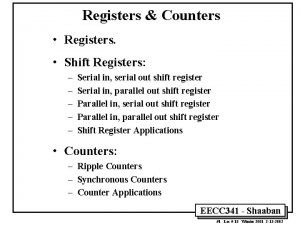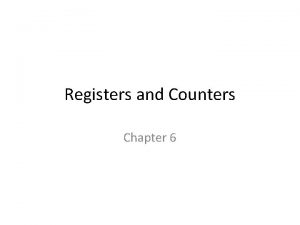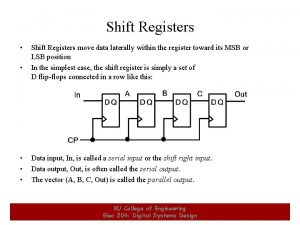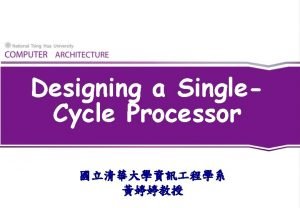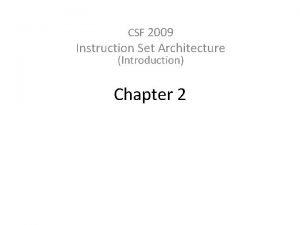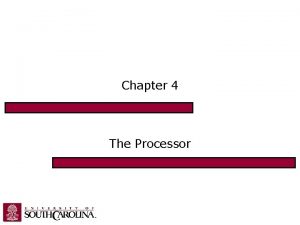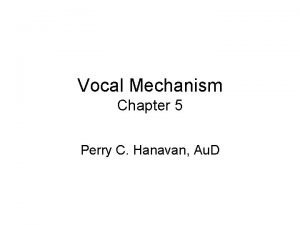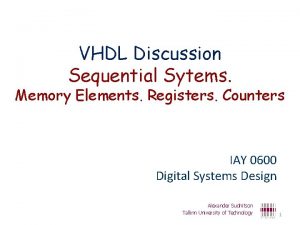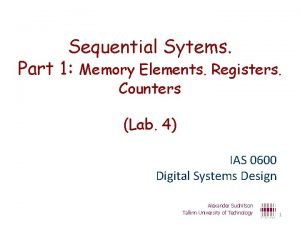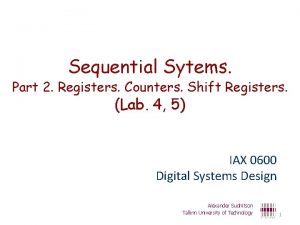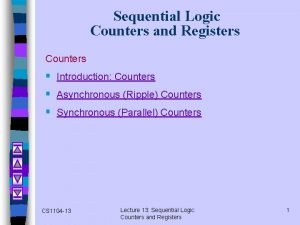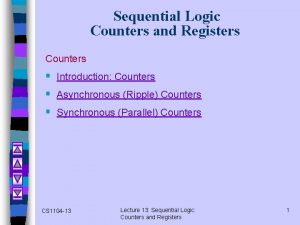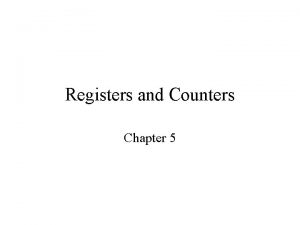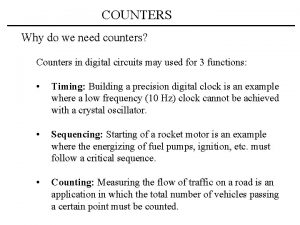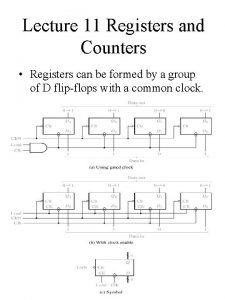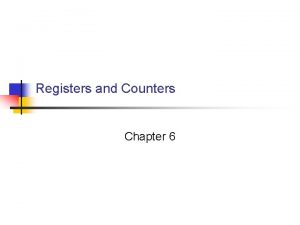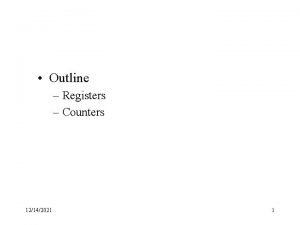VHDL Discussion Sequential Sytems Memory Elements Registers Counters




























- Slides: 28

VHDL Discussion Sequential Sytems. Memory Elements. Registers. Counters IAY 0600 Digital Systems Design Alexander Sudnitson Tallinn University of Technology 1

Sequential systems Digital systems can be classified as either combinational or sequential. As we have seen, a combinational system’s outputs are completely determined by its present input values. In contrast, a sequential system’s outputs depend not only on its present input values, but also on its past history of input values. This history is represented by the binary present state value stored in memory elements in the sequential system. Accordingly, the output of a sequential system is a function of both its present input values and present state (past history of its input values). 2

Memory elemetns A single memory element is, by itself, a simple sequential system that stores 1 bit of information. A memory element has two stable states, corresponding to its storing either a 0 or a 1. When a memory element stores a 0, it is said to be clear. When it stores a 1, it is said to be set. A memory element’s output indicates its present state. 3

Explicit and implicit description of memory elemetns Using VHDL, a memory element can be described either explicitly or implicitly. An explicit description corresponds to the instantiation of a memory element component. In contrast, an implicit description uses a programming style that describes behavior corresponding to that of a memory element. In this later case, a synthesizer infers that a memory element is needed to achieve the described behavior. 4

Clock A clock signal is a train (sequence) of pulses used as a timing signal. The amount of time a periodic signal is 1 during its period (t. H) is constant. This time is the clock’s width. The ratio of the clock’s width to its period (t. H / T), expressed as a percent, is its duty cycle. 5

Latch versus flip-flop Latches and flip-flops are the basic kinds of memory elements. A memory element is categorized as either a latch or a flip-flop, based on to which characteristic of its clock signal it is sensitive. The primary difference between the two is that a latch’s state can be changed by its synchronous inputs during the entire time its clock is asserted. In contrast, a flip-flop’s state can be changed by its synchronous inputs only at the edge of a clock pulse. Flip-flops are used much more extensively as memory elements in designs than are latches. 6

Latch versus flip-flop When a positive-level D latch’s clock input (CLK) is a 1, its Q output value follows its D input value. Under this clock condition, any change at D appears at Q. The input data is said to “flow through” to the output, and the latch is termed transparent. That is, the output tracks the input. 7

Latch versus flip-flop A D flip-flop is an edge-triggered memory element that transfers the value on its D input to its Q output when a triggering edge occurs at its clock input. This output value is stored until the next triggering clock edge. Thus, a D flip-flop can change its state only once during a clock cycle. 8

D latch description library ieee; use ieee. std_logic_1164. all; entity d_latch is port (d: in std_logic; clk: in std_logic; q: out std_logic ); end d_latch; architecture behavioral of d_latch is begin process (d, clk) begin if clk = '1' then q <= d; end if; end process; Latch inferred by end behavioral; 9 synthesizer The sensitivity list must contain all of the signals read within the process.

Equivalent description if clk = '1' then q <= d; end if; 10 if clk = '1' then q <= d; else null; end if;

Detecting clock edges Expressions for a negative clock-edge condition 11

Detecting clock edges Expressions for a positive clock-edge condition 12

Template for positive-edge-triggered D flip flop using if statement 13

Positive-edge-triggered D flip flop library ieee; use ieee. std_logic_1164. all; entity d_ff_pe is port (d, clk: in std_logic; q: out std_logic); end d_ff_pe; architecture behavioral of d_ff_pe is begin process (clk) begin if clk'event and clk = '1' then q <= d; end if; end process; end behavioral; 14

Template for positive-edge-triggered D flip flop with asynchronous set or clear 15

Multibit latches and registers Either latches or flip-flops can be interconnected to form memory structures that store multiple bits of information as a unit. Flipflops can also be combined to form shift registers, shift register counters, and counters. 16

A multibit D latch entity octal_d_latch is port (d: in std_logic_vector(7 downto 0); clk, set_bar, clear_bar: in std_logic; q: out std_logic_vector(7 downto 0)); end octal_d_latch; architecture behavioral of octal_d_latch is begin process (d, clk, set_bar, clear_bar) begin if set_bar = '0' then q <= (others => '1'); elsif clear_bar = '0' then q <= (others => '0'); elsif clk = '1' then q <= d; end if; end process; end behavioral; 17

Shift registers using a buffer mode port This shift register’s serial data input is si. Its serial output is taken from qout(0). The parallel outputs of the shift register are qout(3) down to qout(0). To describe the shift, we need to be able to read the present value in the shift register. If its mode is out, port qout cannot be directly read. Instead, qout is declared as mode buffer. 18

Shift registers using a buffer mode port entity shiftreg_rb is port (si, clr_bar, clk : in std_logic; qout : buffer std_logic_vector (3 downto 0)); end shiftreg_rb; architecture behavior of shiftreg_rb is begin process (clk) begin if rising_edge(clk) then if clr_bar = '0' then qout <= "0000"; -- clear shift register else qout(0) <= qout(1); qout(2) <= qout(3); qout(1) <= qout(2); qout(3) <= si; end if; end process; shift right end behavior; The order in which the flip-flop outputs are read 19 and their values assigned does not matter.

Using a signal to read the value assigned to an output port within an architecture 20

Shift registers using to read a mode out port entity shiftreg_rs is port (si, clr_bar, clk : in std_logic; qout : out std_logic_vector (3 downto 0)); end shiftreg_rs; architecture behavior of shiftreg_rs is signal q : std_logic_vector (3 downto 0); begin process (clk) begin if rising_edge(clk) then if clr_bar = '0' then qout <= "0000"; -- clear shift register else q(0) <= q(1); q(2) <= q(3); q(1) <= q(2); q(3) <= si; end if; Again assignments are listed in a random order. end process; Since these are signal assignments, their values qout <= q; don’t change during the current execution of the process (simulation cycle). 21 end behavior;

Shift registers using variables entity shiftreg_rv is port (si, clr_bar, clk : in std_logic; qout : out std_logic_vector (3 downto 0)); end shiftreg_rv; architecture behavior of shiftreg_rv is begin process (clk) variable q : = std_logic_vector (3 downto 0); begin if rising_edge(clk) then if clr_bar = '0' then q : = "0000"; -- clear shift register else q(0) : = q(1); q(1) : = q(2); q(2) : = q(3); q(3) : = si; end if; qout <= q; If a variable is used, the order of assignment end if; to elements of the variable vector is critical, end process; because each assignment takes effect immediately. 22 end behavior;

Shift registers using concatination operator to shift A shift operation can be written more concisely using the concatenation operator and slices. The concatenation operator is predefined for all one-dimensional array types. q(0) : = q(1); q(1) : = q(2); q(2) : = q(3); q(3) : = si; can be replaced by a single assignment statement: q : = si & q(3 downto 1); si is assigned to q(3) and slice q(3) down to q(1) is assigned to q(2) down to q(0). 23

Counters are simple examples of finite state machines (FSMs). A counter’s next state is the state it goes to from its present state at a triggering clock edge. Example: state diagram for a 3 -bit counter (it has modulus of 8). In VHDL, addition and subtraction operations are predefined for only the types integer, real, and time. Since we are using std_logic or std_logic_vector types for inputs and outputs, we cannot use the predefined + and – operators directly. Two ways to solve this problem are: 1. Use type integer signals or variables along with the predefined + and – operators, then use functions to convert the integer results to std_logic. 2. Use type unsigned from the package NUMERIC_STD, which also overloads the + and – operators for this type, then convert the unsigned results to std_logic_vector. 24

Counters using an integer signal (the first approach) This approach uses an integer signal or a variable to represent the count and the predefined + and – operators. Use of signal count_int is another example of the previously introduced technique used to read the value assigned to a mode out port. library ieee; use ieee. std_logic_1164. all; use ieee. numeric_std. all; entity counter_4 bit is port (clk, reset_bar: in std_logic; count: out std_logic_vector (3 downto 0)); end counter_4 bit; architecture behav_int of counter_4 bit is signal count_int : integer range 0 to 15; begin 25

Counters using an integer signal cnt_int: process (clk, reset_bar) begin if reset_bar = '0' then count_int <= 0; elsif rising_edge(clk) then if count_int = 15 then count_int <= 0; else count_int <= count_int + 1; --read and increment count_int end if; end process; count <= std_logic_vector(to_unsigned(count_int, 4)); end behav_int; 26

Counter using unsigned signal Look next slide: The count is incremented by the statement: count_us <= count_us + 1; In this statement, the integer 1 is added to unsigned signal count_us. Package NUMERIC_STD overloads the + operator so that it can be used to add an unsigned type to a natural type. This package also overloads the + operator so that it can add two unsigned types. An advantage of using an unsigned type in a binary counter is that we do not have to check whether the count is at its maximum value to force it to 0 on the next count. An unsigned vector naturally rolls over to 0 on the next count after it has reached all 1 s (2 n – 1). 27

Counter library ieee; using unsigned signal use ieee. std_logic_1164. all; use ieee. numeric_std. all; entity counter_4 bit is port (clk, reset_bar: in std_logic; count: out std_logic_vector (3 downto 0)); end counter_4 bit; architecture behav_us of counter_4 bit is signal count_us : unsigned(3 downto 0); begin cnt_us: process (clk, reset_bar) begin if reset_bar = '0' then count_us <= "0000"; elsif rising_edge(clk) then count_us <= count_us + 1; end if; end process; A variable maintains its value between 28 executions of a process
 Counters shift registers
Counters shift registers Counters shift registers
Counters shift registers Counters shift registers
Counters shift registers Counters shift registers
Counters shift registers Registers and counters
Registers and counters Home theater sytems
Home theater sytems Fractional distillation introduction
Fractional distillation introduction Eecs 150
Eecs 150 Sequential elements
Sequential elements Sequential elements
Sequential elements Sequential elements
Sequential elements Episodic memory
Episodic memory Implicit memory vs explicit memory
Implicit memory vs explicit memory Long term memory vs short term memory
Long term memory vs short term memory Internal memory and external memory
Internal memory and external memory Primary memory and secondary memory
Primary memory and secondary memory Logical memory vs physical memory
Logical memory vs physical memory Which memory is the actual working memory?
Which memory is the actual working memory? Virtual memory
Virtual memory Virtual memory in memory hierarchy consists of
Virtual memory in memory hierarchy consists of Eidetic memory vs iconic memory
Eidetic memory vs iconic memory Shared memory vs distributed memory
Shared memory vs distributed memory Chalumeau register clarinet
Chalumeau register clarinet Vocal registers
Vocal registers Vocal fry
Vocal fry 80386 registers
80386 registers Model-specific register
Model-specific register Objectives of nhmis
Objectives of nhmis Shift register d flip flop
Shift register d flip flop
